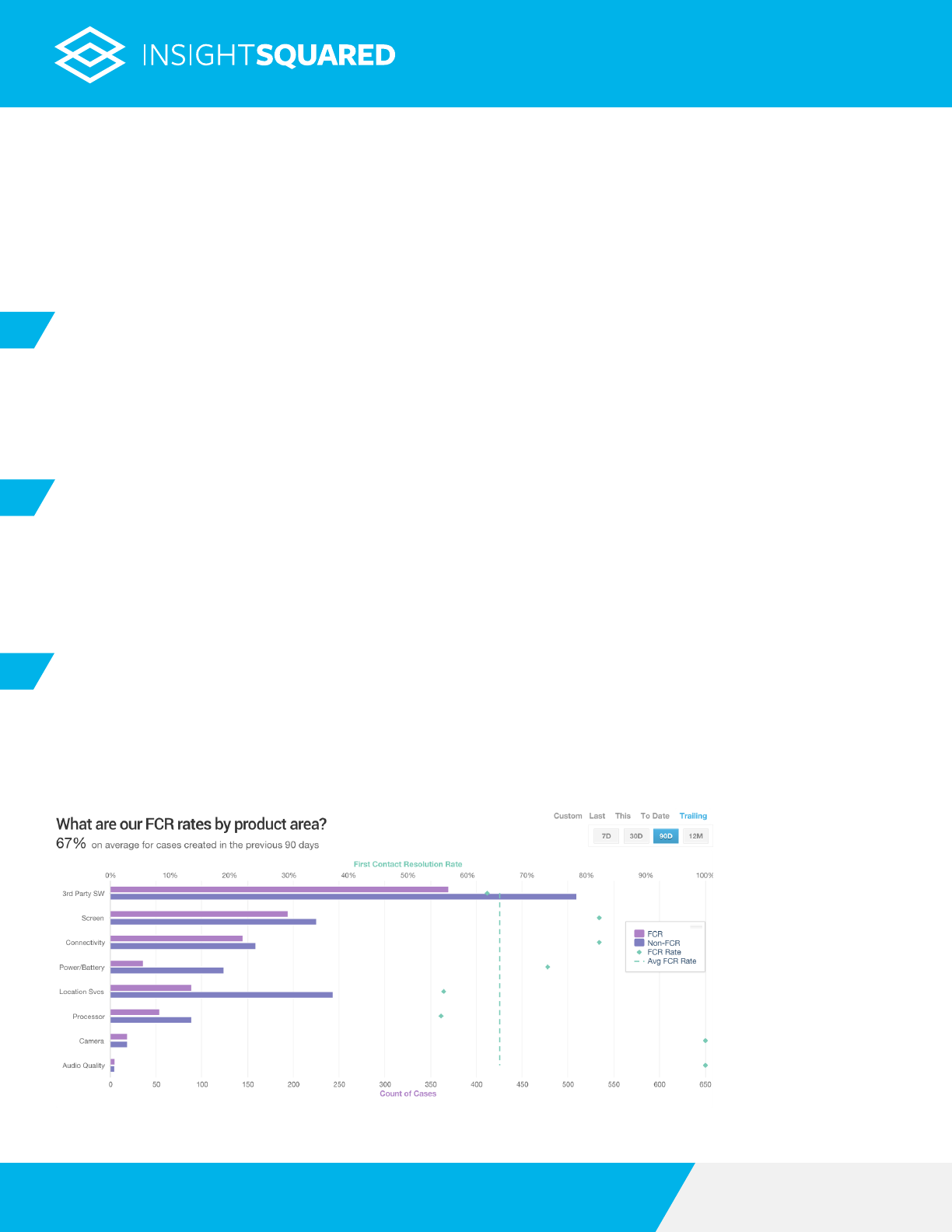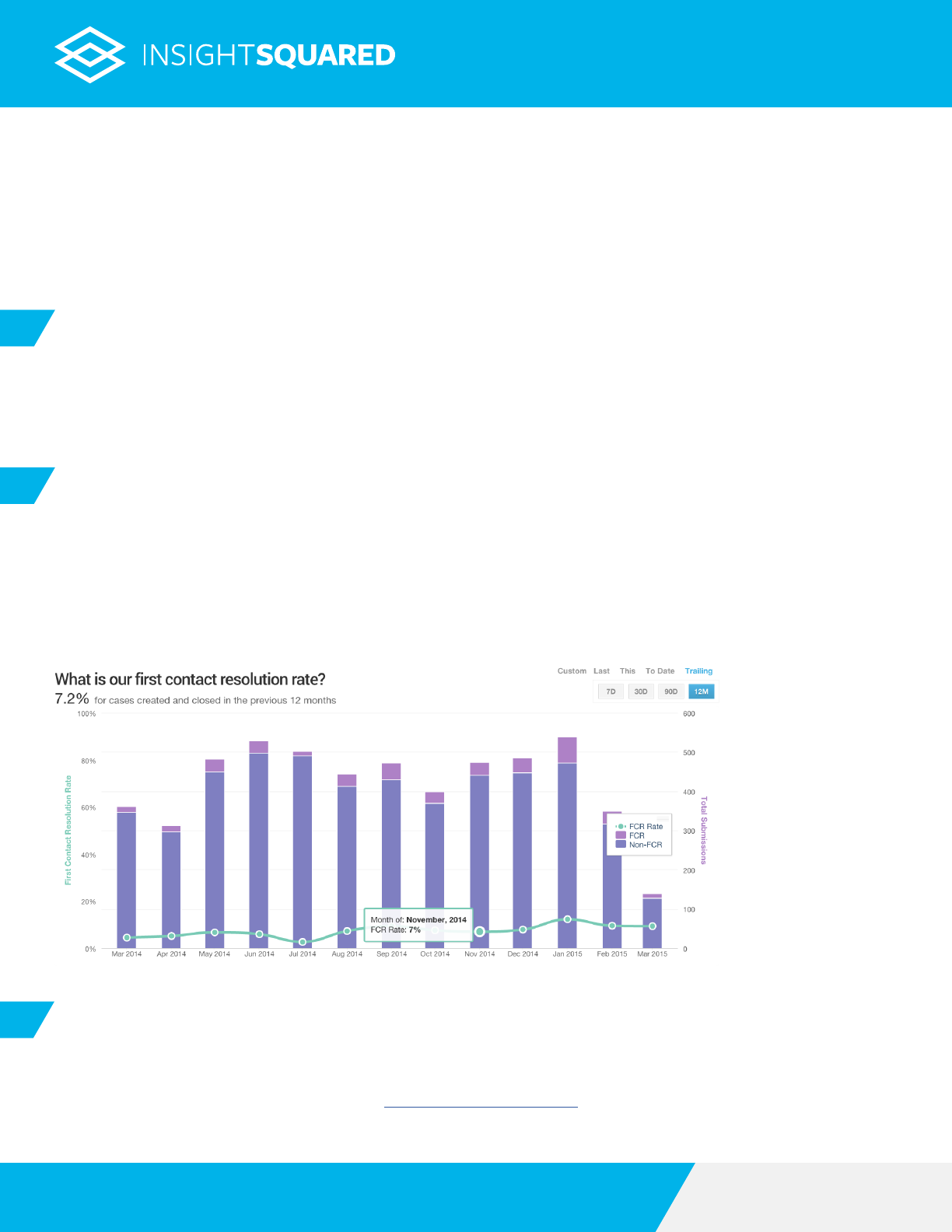
The main goal of customer service teams is to keep customers coming back to your business. In
order to achieve this, you need to make them happy by resolving their problems efciently and
effectively. Unfortunately, there are very few metrics that comprehensively reflect the true
performance of service reps – that’s where First Contact Resolution (FCR) comes in.
Your Guide to First Contact Resolution
Want to track your FCR? Get a FREE demo of InsightSquared. insightsquared.com
What is First Contact Resolution?
A rst contact resolution, sometimes called a one-touch case, is a service issue that is resolved with a single
response activity (e.g. call or email). FCR is referred to as the golden metric of customer service because
it measures both efciency and effectiveness, giving you deep insights into your team’s prociency. It is
typically calculated as a rate, using the following formula:
1
How Does First Contact Resolution Measure Efciency?
For customer service teams, efciency is measured by the amount of time and effort it takes to resolve
customers’ problems. Typically, cases resolved with a single touch are quick and painless, which is why FCR
is such a strong indicator of efciency. By analyzing the trend of your FCR over time, you can easily see if your
team is becoming more efcient at handling cases.
2
# of cases resolved in one response
total # of cases resolved
FCR =
How Does First Contact Resolution Measure Effectiveness?
FCR isn’t just about speed – it also reflects the problem-solving abilities of your team. When your reps are able
to resolve customers’ issues in just a single call or email, their effectiveness is maximized. Tracking your FCR
will show you whether or not your team is consistently having productive interactions with customers.
3
Why Should You Care About First Contact Resolution?
FCR correlates with customer satisfaction – the higher your FCR, the more satised your customers will be.
And if your customers are happy, you will increase your retention rate and reduce churn.
4
If you want to improve the output of your service team, analyzing your FCR is the best place to start. Making an
effort to increase your FCR will boost your team’s productivity, allowing you to handle more volume. This will
save you time in the short-term and reduce costs in the long run.

Simply knowing your FCR isn’t enough – accurately tracking your FCR will enable you to pinpoint
areas of weakness that should be addressed. Before diving in, you need to take a step back and
contemplate what FCR means to your team. Investing the time to analyze your FCR and devising a
plan to optimize it can pay dividends for your organization.
How to Improve Your First Contact Resolution
Want to track your FCR? Get a FREE demo of InsightSquared. insightsquared.com
Decide What FCR Means to Your Team
Service teams handle a wide variety of cases. Each team should identify which of their case types are eligible
for FCR. Not all cases can be resolved in a single response – some are better off measured with other metrics,
such as time to resolution. It can also be useful to add a time limit for FCR eligibility. For example, a case must
be resolved in one touch and within an hour of being opened to count as an FCR.
1
Empower Your Service Reps
Research has shown that time in training directly correlates to FCR. Thoroughly training your service reps, so that
they acquire deep product knowledge, will allow them to resolve issues more easily. You can also set your reps
up for success by giving them the capability to override system rules (when appropriate). This will expedite the
service process and alleviate the need for cross-departmental communication.
2
3
Find Out What’s Holding You Back
In order to reveal why your overall FCR is low, you need to break it down into smaller segments. You can spot
nuances by analyzing each employee’s FCR to see which service reps need more coaching. Or you can look at
FCR by product area to discover which types of issues your reps are having trouble resolving (see gure 1).
3
Figure 1:
In this example, the
FCR rates for Camera
and Audio Quality
product types are
signicantly lower than
the rest. Why is that?
Maybe your reps need
more knowledge on
these product areas –
a new training program
could be your answer.

Although FCR is generally considered an indicator of efciency and effectiveness, there are times
when a higher FCR isn’t necessarily better for your team. When working to improve your FCR, keep in
mind that the primary goal of customer service is to keep customers coming back to your business.
Accomplishing this means making them happy by providing real solutions to their problems.
The Limitations of First Contact Resolution
Want to track your FCR? Get a FREE demo of InsightSquared. insightsquared.com
Do What’s Best for the Customer
Don’t inflate your FCR with easy wins. If your reps are answering certain questions easily because of an
internal wiki, why not put it in the public knowledge base to prevent those case types from clogging your
queue? This would make life easier for your customers, which is more important than improving any metric.
1
Don’t Manage to the Metric
If you place too much emphasis on optimizing your team’s FCR, your reps may be tempted to juke the stats,
or consciously sacrice the quality of their work just to hit their numbers (see gure 2). It’s inefcient for your
reps to close cases after the rst response if the customer’s problem hasn’t actually been resolved – this will
result in higher reopen rates. If you’re going to make an effort to improve your FCR, make sure to stress the
importance of verifying resolutions before closing cases.
2
Apply Your Knowledge
Analyzing your FCR will help you gauge your team’s performance to pinpoint areas of weakness. When
taking the steps to improve your FCR, you must remember to always put the customer rst. If you need help
visualizing the trend of your FCR over time, click here for a free demo of InsightSquared Service Analytics to
see how you can make your service team more efcient and effective.
3
3
Figure 2:
In this example, the
FCR rate increases
signicantly from Dec.
2014 to Jan. 2015.
So, that’s good, right?
Well, not always.
Maybe the service reps
were juking the stats,
turning FCR into a
vanity metric.
